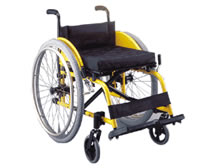The Wheelchair Guide
Your Wheelchair and Mobility Scooter Resource
How Manual Wheelchairs Work
Friday, October 2nd, 2009 at 8:56 am
Wheelchairs have been around, albeit in a much less standard form, for thousands of years. Their roots can be traced back to images of ancient oriental devices, which were designed to provide a way for those who could not walk to get around. Today, despite there being a great number of wheelchair manufacturers around, the general design of the manual wheelchair has become much more standardized.
The modern manual wheelchair is based off of the more than 70 year old E&J wheelchair design, which features a hollow metal tube frame, two large rear wheels, and a smaller set of front wheels. When not in use, the frame can be folded, making it easier to transport and move the wheelchair.
Standard Manual Wheelchair Design
 The large rear wheels allows the user of the wheelchair to self-propel, grasping the rear wheels, which have an extended rim, called a handrim, that does not come in contact with the ground and user to spin the rear wheels.
The large rear wheels allows the user of the wheelchair to self-propel, grasping the rear wheels, which have an extended rim, called a handrim, that does not come in contact with the ground and user to spin the rear wheels.
Even though many manual wheelchairs are designed to be self propelled, this is not always the case. Some manual wheelchairs, called transport wheelchairs or transfer wheelchairs, are designed only to be pushed from behind, so feature much smaller rear wheels. They also have a set of push handles that extend from the top of the wheelchair frame, on both corners of the top seat. Most manual wheelchairs also include these push handles, although sports wheelchairs frequently do not.
The front rigging of the manual wheelchair refers to the footrest and supports, which can often be removed and adjusted to increase comfort. The front rigging varies by wheelchair, but most provide a metal foot rest, which can be folded up to allow the wheelchair user to enter and exit the chair.
A braking system is also present on most standard manual wheelchairs, although sports wheelchairs, which have a slightly different design in general, often do not include brakes. When brakes are present, however, they usually use a simple design that holds the rear wheels in place using a simple vice, which is applied separately to both wheels. This allows the person using the wheelchair to easily set the brake, with only a little pressure.
Anti-tip casters are another important feature, which extend from the rear of the wheelchair frame. They are basically like little arms, which are designed to make contact with the ground if the wheelchair tips over too far backwards. The anti-tip casters can not always prevent a fall, but they often make tipping over backwards much less dangerous.
Sports Wheelchairs vs Manual Wheelchairs
 More and more, the sports wheelchair is becoming popular, not just for those who play wheelchair sports, such as wheelchair basketball or wheelchair racing, but also those who simply find sports wheelchairs more comfortable and practical. One major difference between sports wheelchairs and manual wheelchairs is the seat design.
More and more, the sports wheelchair is becoming popular, not just for those who play wheelchair sports, such as wheelchair basketball or wheelchair racing, but also those who simply find sports wheelchairs more comfortable and practical. One major difference between sports wheelchairs and manual wheelchairs is the seat design.
Manual wheelchairs usually use a vinyl like material, which is sewn around the hollow tubed frame. Sports wheelchairs, on the other hand, often use a much more breathable material, which is usually softer and a good deal thicker than the vinyl seat found on a conventional wheelchair. This makes it more comfortable and less likely to cause irritations due to sweat, as well as drying much quicker.
Another major difference is the backrest. Most manual wheelchairs have a full backrest, which sports wheelchairs usually have a much smaller and lower backrest. This is one of the features that many non-sports playing wheelchair users appreciate, because it can be much more comfortable and practical indoors, allowing for a much larger range of movement in regards to the arms and shoulders. This can be important when working at a desk, as it allows the wheelchair user to reach around easily.
There are many other differences between sports wheelchairs and manual wheelchairs, including how the front rigging is designed, as well as the size and angle of the wheels. The axle is usually much different on a sports wheelchair as well.